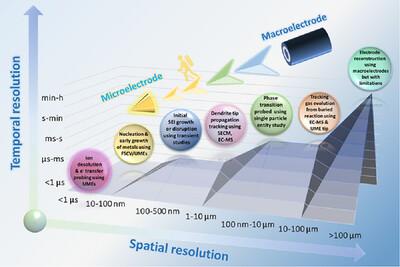Probing Battery Interfaces and Interphases with Microelectrodes: Spatially and Temporally Resolved Single‐Entity Measurements
IF 26
1区 材料科学
Q1 CHEMISTRY, PHYSICAL
引用次数: 0
Abstract
Understanding batteries at the level of individual particles and interfaces, where critical electrochemical processes actually occur, remains a grand challenge in energy storage research. Traditional characterization techniques often average over complex, heterogeneous structures, obscuring localized events such as nucleation and phase transformation that ultimately dictate battery performance and degradation. Microelectrodes offer a unique opportunity to overcome this limitation by enabling spatially and temporally resolved probing of electrochemical reactions at the microscale. Their reduced dimensions facilitate rapid steady‐state responses, minimal ohmic‐drop, and hemispherical diffusion, making them ideally suited for investigating fast kinetics, localized transport phenomena, and single‐entity redox behavior under realistic battery operating conditions. This review critically examines the growing role of microelectrodes in battery science: from measuring intrinsic charge transfer and diffusion coefficients to mapping morphological transitions and probing interfacial instabilities. It highlights when integrated with advanced characterization tools and operando platforms, microelectrodes can unravel reaction pathways inaccessible to macroscale techniques. Moving forward, it outlines key research directions where microelectrode‐based platforms can make transformative contributions, particularly in non‐equilibrium systems, emerging chemistries, and data‐integrated diagnostics. By reframing batteries as inherently heterogeneous and dynamic systems, microelectrodes emerge as enabling tools for mechanistic understanding and precision control in next‐generation energy storage technologies.

用微电极探测电池界面和界面:空间和时间分辨的单实体测量
在单个粒子和界面水平上理解电池,这是关键的电化学过程实际发生的地方,仍然是能量存储研究中的一个巨大挑战。传统的表征技术通常对复杂的异质结构进行平均化,掩盖了最终决定电池性能和退化的局部事件,如成核和相变。微电极提供了一个独特的机会来克服这一限制,使空间和时间在微观尺度上解决电化学反应的探测。其减小的尺寸有助于快速稳态响应,最小的欧姆降和半球形扩散,使其非常适合研究快速动力学,局部输运现象和现实电池工作条件下的单实体氧化还原行为。本文综述了微电极在电池科学中日益增长的作用:从测量内在电荷转移和扩散系数到映射形态转变和探测界面不稳定性。它强调,当与先进的表征工具和操作平台集成时,微电极可以揭示宏观技术无法实现的反应途径。展望未来,它概述了基于微电极的平台可以做出变革性贡献的关键研究方向,特别是在非平衡系统,新兴化学和数据集成诊断方面。通过将电池重新定义为固有的异构和动态系统,微电极成为下一代储能技术中机械理解和精确控制的工具。
本文章由计算机程序翻译,如有差异,请以英文原文为准。
求助全文
约1分钟内获得全文
求助全文
来源期刊

Advanced Energy Materials
CHEMISTRY, PHYSICAL-ENERGY & FUELS
CiteScore
41.90
自引率
4.00%
发文量
889
审稿时长
1.4 months
期刊介绍:
Established in 2011, Advanced Energy Materials is an international, interdisciplinary, English-language journal that focuses on materials used in energy harvesting, conversion, and storage. It is regarded as a top-quality journal alongside Advanced Materials, Advanced Functional Materials, and Small.
With a 2022 Impact Factor of 27.8, Advanced Energy Materials is considered a prime source for the best energy-related research. The journal covers a wide range of topics in energy-related research, including organic and inorganic photovoltaics, batteries and supercapacitors, fuel cells, hydrogen generation and storage, thermoelectrics, water splitting and photocatalysis, solar fuels and thermosolar power, magnetocalorics, and piezoelectronics.
The readership of Advanced Energy Materials includes materials scientists, chemists, physicists, and engineers in both academia and industry. The journal is indexed in various databases and collections, such as Advanced Technologies & Aerospace Database, FIZ Karlsruhe, INSPEC (IET), Science Citation Index Expanded, Technology Collection, and Web of Science, among others.
 求助内容:
求助内容: 应助结果提醒方式:
应助结果提醒方式:


